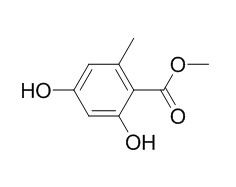Methyl orsellinate
Methyl orsellinate is a phytotoxic compound, it exhibits antifungal activity, it can cause significant inhibition of radicle growth of Amaranthus hypochondriacus and Echinochloa crus-galli, interact with bovine-brain calmodulin and inhibit the activation of the calmodulin-dependent enzyme cAMP phosphodiesterase. Methyl orsellinate can inhibit PTP1B activity with 50% inhibitory concentration values of 277 +/- 8.6 microM, the selective inhibition of PTP1B has been widely recognized as a potential drug target for the treatment of type 2 diabetes and obesity, methyl orsellinate may can treat the type 2 diabetes and obesity.
Inquire / Order:
manager@chemfaces.com
Technical Inquiries:
service@chemfaces.com
Tel:
+86-27-84237783
Fax:
+86-27-84254680
Address:
1 Building, No. 83, CheCheng Rd., Wuhan Economic and Technological Development Zone, Wuhan, Hubei 430056, PRC
Providing storage is as stated on the product vial and the vial is kept tightly sealed, the product can be stored for up to
24 months(2-8C).
Wherever possible, you should prepare and use solutions on the same day. However, if you need to make up stock solutions in advance, we recommend that you store the solution as aliquots in tightly sealed vials at -20C. Generally, these will be useable for up to two weeks. Before use, and prior to opening the vial we recommend that you allow your product to equilibrate to room temperature for at least 1 hour.
Need more advice on solubility, usage and handling? Please email to: service@chemfaces.com
The packaging of the product may have turned upside down during transportation, resulting in the natural compounds adhering to the neck or cap of the vial. take the vial out of its packaging and gently shake to let the compounds fall to the bottom of the vial. for liquid products, centrifuge at 200-500 RPM to gather the liquid at the bottom of the vial. try to avoid loss or contamination during handling.
Appl. Sci.2020, 10(16),5482.
Genes Genomics.2020, 10.1007
Food Funct.2024, 15(4):1852-1866.
Molecules.2021, 26(2):313.
BMC Plant Biol.2020, 20(1):214.
Saudi Pharm J2020, 10.1016
Front Pharmacol.2020, 11:566490.
Phytomedicine.2022, 110:154597.
Biomedicine & Pharmacotherapy2022, 153:113404.
J Ethnopharmacol.2016, 192:370-381
Related and Featured Products
Phytomedicine. 2002 Oct;9(7):654-8.
Effects of tenuiorin and methyl orsellinate from the lichen Peltigera leucophlebia on 5-/15-lipoxygenases and proliferation of malignant cell lines in vitro.[Pubmed:
12487331]
METHODS AND RESULTS:
The orcinol derivatives tenuiorin (1) and Methyl orsellinate (2) were identified as active components of an extract from the lichen Peltigera leucophlebia (Nyl.) Gyeln. showing in vitro inhibitory activity against 15-lipoxygenase from soybeans. The compounds were subsequently tested for in vitro activity against 5-lipoxygenase from porcine leucocytes and proved to be moderately active, with IC50 values of 41.6 microM and 59.6 microM respectively. Tenuiorin is a known constituent of several Peltigera species but has not previously been isolated from P. leucophlebia. As correlation between 5-lipoxygenase inhibition and antiproliferative effects has earlier been witnessed for related lichen metabolites, tenuiorin and Methyl orsellinate were further tested for antiproliferative activity on cultured human breast (T-47D)-, pancreatic (PANC-1)- and colon (WIDR) cancer cell lines.
CONCLUSIONS:
The monomeric Methyl orsellinate exhibited no detectable antiproliferative activity whereas the trimeric tenuiorin caused moderate/weak reduction in [3H]-thymidine uptake of the pancreatic- and colon cancer cells, with ED50 values of 87.9 and 98.3 microM respectively.
Phytochemistry. 2003 Sep;64(1):285-91.
Phytotoxic compounds from Flourensia cernua.[Pubmed:
12946427]
METHODS AND RESULTS:
Bioassay-directed fractionation of a CH(2)Cl(2)-MeOH (1:1) extract of the aerial parts of Flourensia cernua led to the isolation of three phytotoxic compounds, namely, dehydroflourensic acid (1), flourensadiol (2) and Methyl orsellinate (3). Dehydroflourensic acid is a new natural product whose structure was established by spectral means. In addition, the known flavonoid ermanin and seven hitherto unknown gamma-lactones were obtained, these being tetracosan-4-olide, pentacosan-4-olide, hexacosan-4-olide, heptacosan-4-olide, octacosan-4-olide, nonacosan-4-olide, and triacontan-4-olide.
CONCLUSIONS:
Compounds 1-3 caused significant inhibition of radicle growth of Amaranthus hypochondriacus and Echinochloa crus-galli, interacted with bovine-brain calmodulin and inhibited the activation of the calmodulin-dependent enzyme cAMP phosphodiesterase.
J. Gen.Microbiol.,1993,139(1):153-9.
Two new antifungal metabolites produced by Sparassis crispa in culture and in decayed trees.[Reference:
WebLink]
METHODS AND RESULTS:
The basidiomycete fungus Sparassis crispa produced three antifungal compounds during submerged culture in 2% malt broth. One compound appeared to be sparassol (methyl-2-hydroxy-4-methoxy-6-methylbenzoate), first characterized in 1924. The other two, termed ScI and ScII, exhibited considerably greater antifungal activity than did sparassol against Cladosporium cucumerinum, and were characterized as methyl-2,4-dihydroxy-6-methylbenzoate (Methyl orsellinate) and an incompletely determined methyl-dihydroxy-methoxy-methylbenzoate, respectively.
CONCLUSIONS:
Both compounds were found in the decayed wood of trees, where their presence was diagnostic of S. crispa infection. The possible ecological role of these compounds is discussed.
J Enzyme Inhib Med Chem. 2009 Oct;24(5):1133-7.
PTP1B inhibitory effects of tridepside and related metabolites isolated from the Antarctic lichen Umbilicaria antarctica.[Pubmed:
19619069 ]
The selective inhibition of PTP1B has been widely recognized as a potential drug target for the treatment of type 2 diabetes and obesity.
METHODS AND RESULTS:
In the course of screening for PTP1B inhibitory natural products, the MeOH extract of the dried sample of the Antarctic lichen Umbilicaria antarctica was found to exhibit significant inhibitory effect, and the bioassay-guided fractionation and purification afforded three related lichen metabolites 1-3. Compounds 1-3 were identified as gyrophoric acid (1), lecanoric acid (2), and Methyl orsellinate (3) mainly by analysis of NMR and MS data.
CONCLUSIONS:
These compounds inhibited PTP1B activity with 50% inhibitory concentration values of 3.6 +/- 0.04 microM, 31 +/- 2.7 microM, and 277 +/- 8.6 microM, respectively. Furthermore, the kinetic analysis of PTP1B inhibition by compound 1 suggested that the compound inhibited PTP1B activity in a non-competitive manner.



